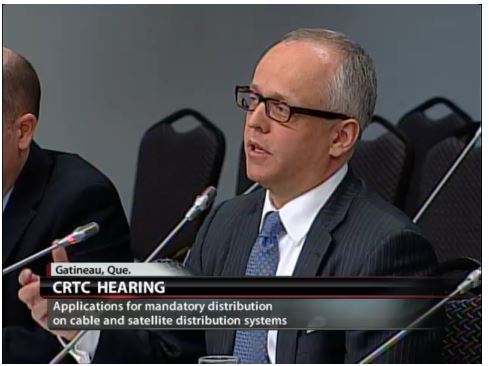
GATINEAU – Shaw Communications was the first broadcast distributor to take the stand before the CRTC?s 9(1)(h) hearing on Monday and it appealed to the Commission to ensure that it maintained high standards when considering additional channels for mandatory carriage.
Jean Brazeau, senior VP of regulatory at Shaw, noted during his opening remarks that exceptional importance should be the minimum threshold that channels need to meet to achieve mandatory carriage status. ?Once satisfied, the applicant still must meet the additional criteria. This includes demonstrating ?extraordinary? need among an intended audience and widespread acceptance by Canadians of an increase in the price of their basic service,? he argued.
Under questioning from commissioner Stephen Simpson, Brazeau added that there has to be ?real meaning? behind this objective.
?I think if we look at how the Commission has applied it in the past, there are some obvious conclusions that we can make that exceptional means more than good or okay or we have to redress a disadvantage that we suffered in the past or things of that nature,? he said.
The company also argued that some of the applicants are using the hearing to get mandatory carriage for services that aren?t unique or meet the exceptional objective. They?re trying ?to return to an outdated protectionist framework,? said Barbara Williams, senior VP of content at Shaw.
She said that all-Canadian film channel Starlight is a prime example of this.
?I think it?s a very old fashioned way to assume that the only way we?re going to get any attention (for Canadian movies) is to put it all on one linear service and force that linear service into a home and think that by some great act of God therefore people are going to turn it on and suddenly watch Monday nights to find the Quebec films and Wednesday night to find the whatever,? Williams argued under questioning. ?Frankly from my point of view, [this] is a very old fashioned approach to curating content and encouraging Canadians to find it.?
Rogers Communications added that contrary to suggestions from Starlight that there is a void for Canadian theatrical films on TV, this is simply not the case. There were nearly 11,000 broadcasts of Canadian films on linear channels in 2012, more than double than what aired in 2008, company executives said in its opening presentation.
?Clearly, there is no Canadian feature film void,? said Pam Dinsmore, VP of regulatory at Rogers. ?Viewers are able to access movies, including Canadian films, from multiple sources. And they are able to get them whenever they want and on the device of their choosing.?
VisionTV was also a topic of conversation during Monday?s hearing. Rogers discounted suggestions from the faith-based channel that the sky is falling. Because the channel has broad appeal to a certain segment of the Canadian population, it?s unlikely Rogers would move the channel in the event that it lost its current status.

Rogers does take issue with giving a channel 9(1)(h) status because it removes the incentive for that service to innovate. Rather than limits its efforts to linear television, VisionTV should be pursuing all rights associated with its programming, said David Purdy (pictured in a screen cap from CPAC.ca), senior VP of content at Rogers, referring largely to Downton Abby.
?That means the VOD rights for the set top box and the broadband rights for tablet, PC and mobile viewing and increasingly we?re pushing the networks to secure those rights,? he said. ?We believe it?s in their enlightened self interest but it?s pushing them beyond their comfort zone because& if a company like Vision doesn?t secure those rights, they?re not doing what?s necessary to protect the system and their business.?
The broadcast distributors also addressed the issue of costs during their appearances on Monday. Both Shaw and MTS Allstream noted that giving more channels 9(1)(h) status would simply drive costs up for consumers. ?At a time when technology is providing customers with greater options for access to content, the broadcast system should not be looking at ways to force programming on viewers,? said Teresa Griffin-Muir, VP of regulatory affairs at MTS. ?This will simply drive consumers away from the system.?
On a number of occasions throughout the hearing, commissioners wondered what the cost to distributors is to add carry a channel. Earlier in the proceeding Starlight noted that this cost was just $0.162 per month per customer.
David Watt, VP of regulatory, telecommunications at Rogers, provided an in-depth explanation of the costs included, and those that aren?t, in carrying a channel. Physical plant and maintenance of the plant are included while other operating costs such as engineering, marketing, finance aren?t. As well, there are other elements to consider when looking at this figure, Watt said. Inflation has boosted this base cost to about $0.22 per month per subscriber. Nor does this include the fact that the company's subscription penetration per homes passed has dropped from 81.7% to 58.1%. (An earlier version of this story incorrectly quoted Rogers average subscription penetration. Cartt.ca regrets the error.)
?That requires a unit cost increase of 40%,? he said. ?So the $0.22 increase by 40% gets it to roughly $0.315 and that would be the physical plant cost of carrying the channel and the maintenance associated with that channel.?
The next two days at the hearing will include presentations from parties supporting certain applications. Replies from the applicants are scheduled to start on Thursday, May 2.



